An Experimental Investigation on Mechanical Properties and Failure Characteristics of Layered Rock Mass
Abstract
1. Introduction
2. Uniaxial Compression Test of Layered Rock Mass
2.1. Test Scheme
2.2. Test Results
3. Mechanical Properties of Layered Rock Mass
3.1. Comparative Analysis of Compressive Strength
3.2. Comparative Analysis of Elastic Modulus
4. Failure Characteristics of Layered Rock Mass
4.1. Analysis of Stress–Strain Curve
4.2. Damage Pattern of Rock Sample
5. Conclusions
Author Contributions
Funding
Institutional Review Board Statement
Informed Consent Statement
Data Availability Statement
Conflicts of Interest
References
- Wagner, H. Deep Mining: A Rock Engineering Challenge. Rock Mech. Rock Eng. 2019, 52, 1417–1446. [Google Scholar] [CrossRef]
- Buddington, A.F. Layered igneous rocks. Chem. Geol. 1970, 6, 241–243. [Google Scholar] [CrossRef]
- Suo, Y.; Chen, Z.; Rahman, S.S.; Chen, X. Experimental study on mechanical and anisotropic properties of shale and estimation of uniaxial compressive strength. Energy Sources Part A Recovery Util. Environ. Eff. 2020. [Google Scholar] [CrossRef]
- Hou, P.; Gao, F.; Yang, Y.; Zhang, X.; Zhang, Z. Effect of the layer orientation on mechanics and energy evolution characteristics of shales under uniaxial loading. Int. J. Min. Sci. Technol. 2016, 26, 857–862. [Google Scholar] [CrossRef]
- Li, H.; Yang, Z.; Li, H. Mechanical Characteristics and Failure Mechanism of Siltstone with Different Joint Thickness. Adv. Civ. Eng. 2020, 2020, 3824538. [Google Scholar] [CrossRef]
- Abdi, Y.; Khanlari, G.-R.; Jamshidi, A. Correlation between Mechanical Properties of Sandstones and P-Wave Velocity in Different Degrees of Saturation. Geotech. Geol. Eng. 2018. [Google Scholar] [CrossRef]
- Ma, J.; Jiang, N.; Wang, X.; Jia, X.; Yao, D. Numerical Study of the Strength and Characteristics of Sandstone Samples with Combined Double Hole and Double Fissure Defects. Sustainability 2021, 13, 7090. [Google Scholar] [CrossRef]
- Yan, C.; Deng, J.; Hu, L.; Chen, Z.; Yan, X.; Lin, H.; Tan, Q.; Yu, B. Brittle failure of shale under uniaxial compression. Arab. J. Geosci. 2015, 8, 2467–2475. [Google Scholar]
- Zhang, J. Borehole stability analysis accounting for anisotropies in drilling to weak bedding planes. Int. J. Rock Mech. Min. Sci. 2013, 60, 160–170. [Google Scholar] [CrossRef]
- Everitt, R.A.; Lajtai, E.Z. The influence of rock fabric on excavation damage in the Lac du Bonnett granite. Int. J. Rock Mech. Min. Sci. 2004, 41, 1277–1303. [Google Scholar] [CrossRef]
- Zheng, Y.; He, R.; Huang, L.; Bai, Y.; Wang, C.; Chen, W.; Wang, W. Exploring the effect of engineering parameters on the penetration of hydraulic fractures through bedding planes in different propagation regimes. Comput. Geotech. 2022, 146, 104736. [Google Scholar] [CrossRef]
- Huang, L.; Liu, J.; Zhang, F.; Dontsov, E.; Damjanac, B. Exploring the influence of rock inherent heterogeneity and grain size on hydraulic fracturing using discrete element modeling. Int. J. Solids Struct. 2019, 176–177, 207–220. [Google Scholar] [CrossRef]
- Duffaut, P. Structural Weaknesses in Rocks and Rock Masses Tentative Classification and Behaviour. In Proceedings of the Isrm International Symposium, ISRM-IS, Tokyo, Japan, 21–24 September 1981. [Google Scholar]
- Chen, S.; Yin, D.; Jiang, N.; Wang, F.; Zhao, Z. Mechanical properties of oil shale-coal composite samples. Int. J. Rock Mech. Min. Sci. 2019, 123, 104120. [Google Scholar] [CrossRef]
- Sun, W.-T.; Li, Z.-H.; Lou, Y.-S.; Zhu, L.; Wu, H.-M.; Lenwoue, A.R.K.; Liu, Q. Mechanical Properties of Shale-Reservoir Rocks Based on Stress–Strain Curves and Mineral Content. Geofluids 2022, 2022, 2562872. [Google Scholar] [CrossRef]
- Wang, Z.; Wang, M.; Zhou, L.; Zhu, Z.; Shu, Y.; Peng, T. Research on uniaxial compression strength and failure properties of stratified rock mass. Theor. Appl. Fract. Mech. 2022, 121, 103499. [Google Scholar] [CrossRef]
- Huang, W.; Wang, H.; Zhang, T.; He, M.; Yan, L. Hydraulic pressure effect on mechanical properties and permeabilities of layered rock mass: An experimental study. Eur. J. Environ. Civ. Eng. 2023, 27, 2422–2433. [Google Scholar] [CrossRef]
- Li, H.; Wang, J.; Li, H.; Wei, S.; Li, X. Experimental Study on Deformation and Strength Characteristics of Interbedded Sandstone with Different Interlayer Thickness under Uniaxial and Triaxial Compression. Processes 2022, 10, 285. [Google Scholar] [CrossRef]
- Li, F.; Yin, D.; Wang, F.; Jiang, N.; Li, X. Effects of combination mode on mechanical properties of bi-material samples consisting of rock and coal. J. Mater. Res. Technol. 2022, 19, 2156–2170. [Google Scholar] [CrossRef]
- Douma, L.A.; Regelink, J.A.; Bertotti, G.; Boersma, Q.D.; Barnhoorn, A. The mechanical contrast between layers controls fracture containment in layered rocks. J. Struct. Geol. 2019, 127, 103856. [Google Scholar] [CrossRef]
- Li, J.; Yu, Z.; Zhou, Z.; Wang, Y.; Li, J. Mechanical analysis and failure modes prediction of composite rock under uniaxial compression. Sci. Rep. 2021, 11, 22826. [Google Scholar] [CrossRef]
- Zhang, L.; Qu, G.; Qu, S.; Liu, Z. Constitutive model and elastic parameters for layered rock mass based on combined Hooke spring. Strength Fract. Complex. 2017, 10, 145–156. [Google Scholar]
- Wei, W.; Zhu, L.; Liu, H. Anisotropy of deformation parameters of stratified rock mass. Arab. J. Geosci. 2021, 14, 1675. [Google Scholar] [CrossRef]
- Berisavljević, Z.; Berisavljević, D.; Rakić, D.; Hadži-Niković, G.; Radić, Z. Strength of composite flysch samples under uniaxial compression. Bull. Eng. Geol. Environ. 2018, 77, 791–802. [Google Scholar] [CrossRef]
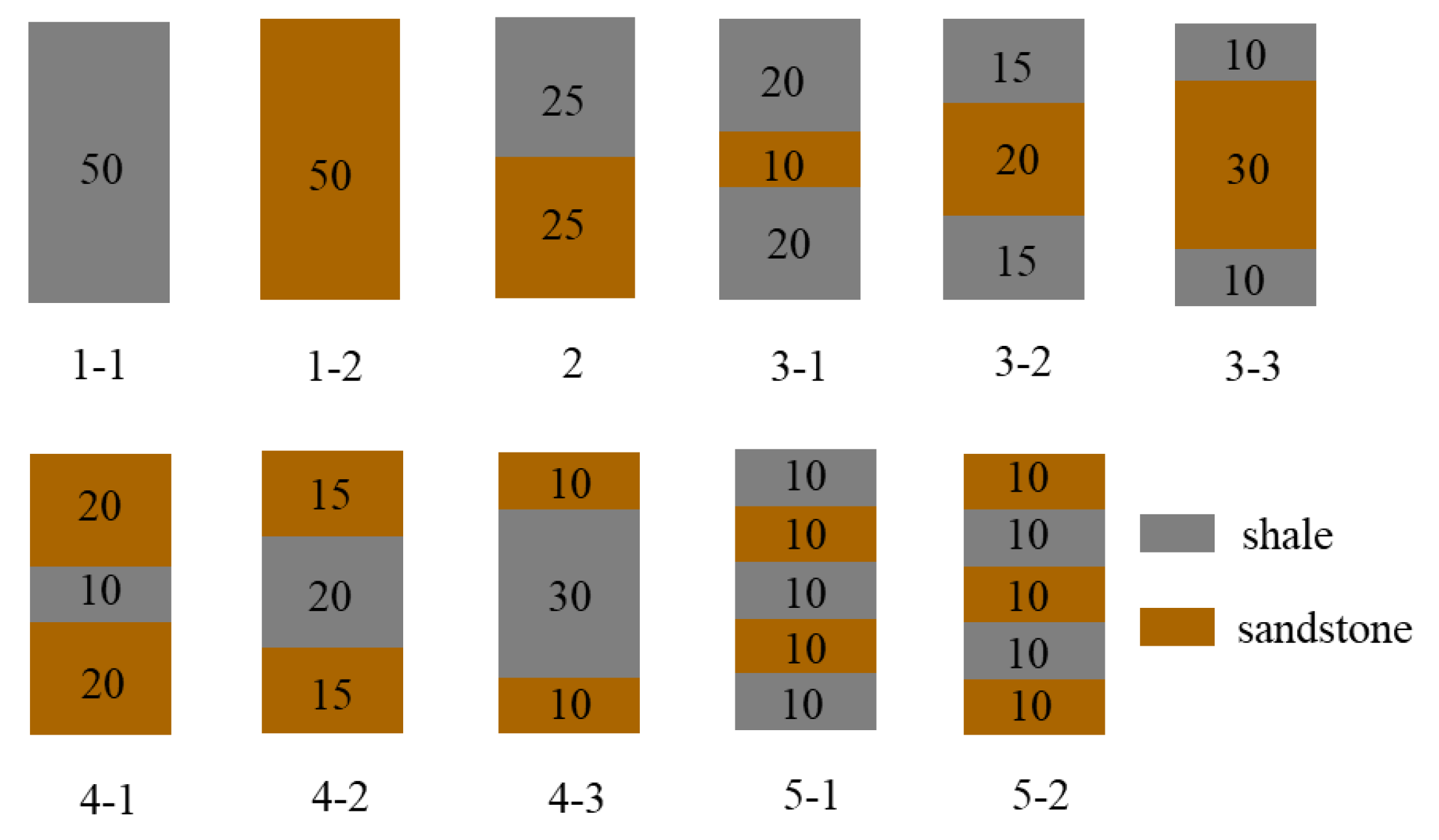



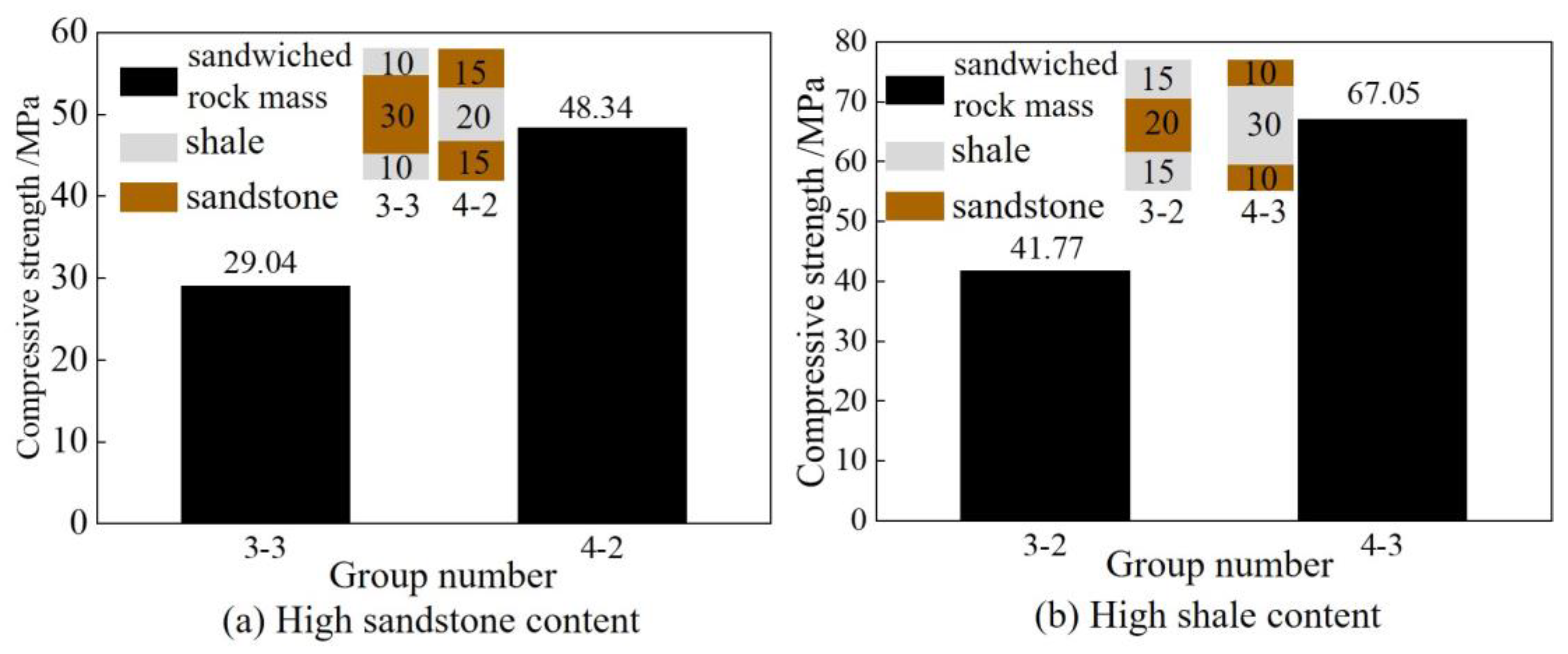



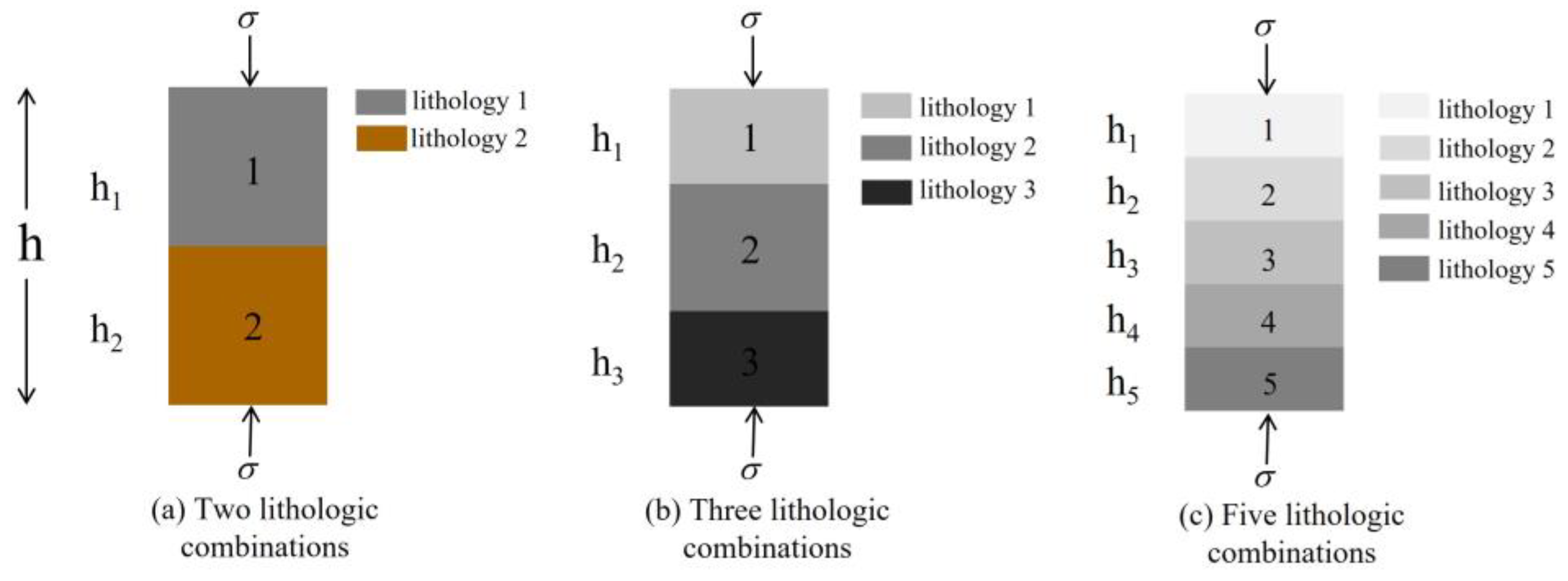
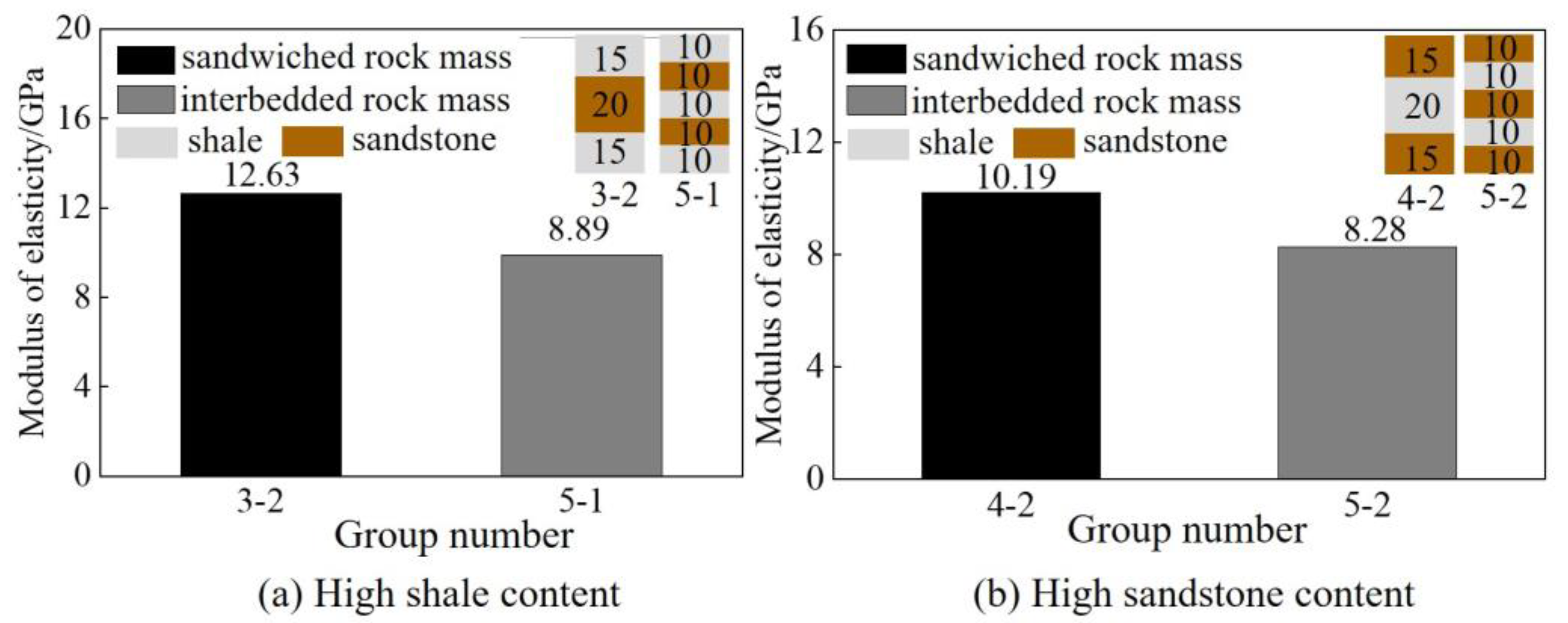

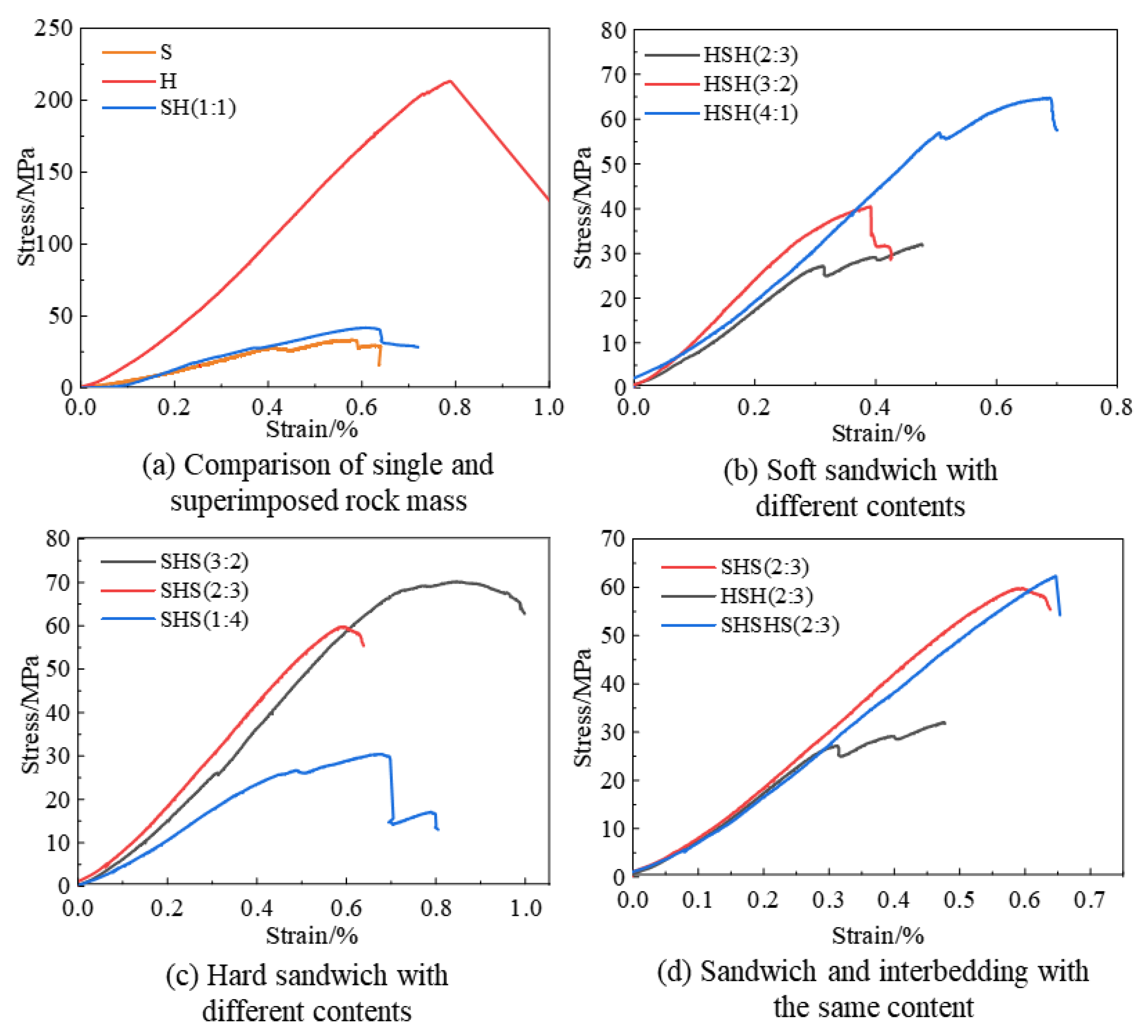

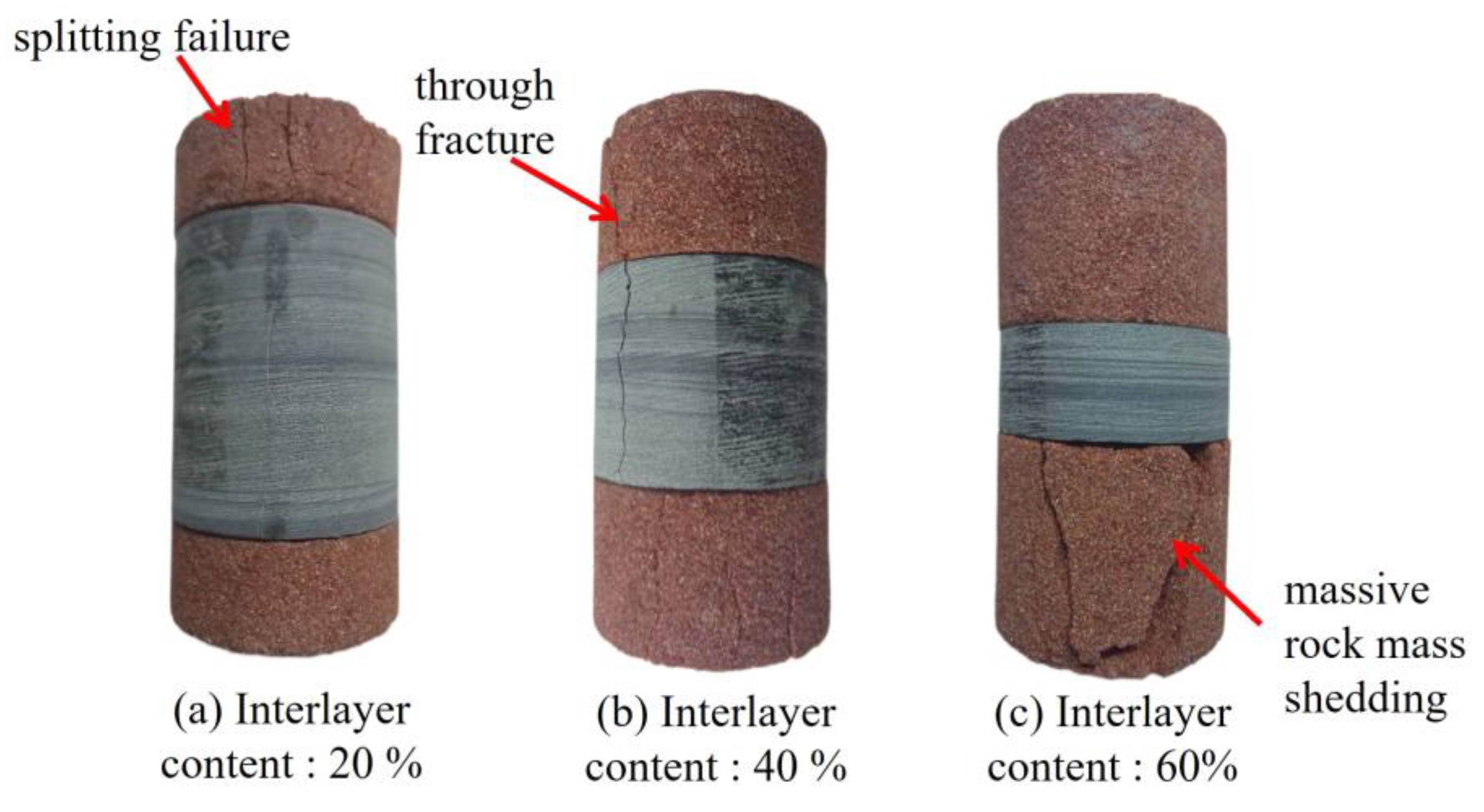
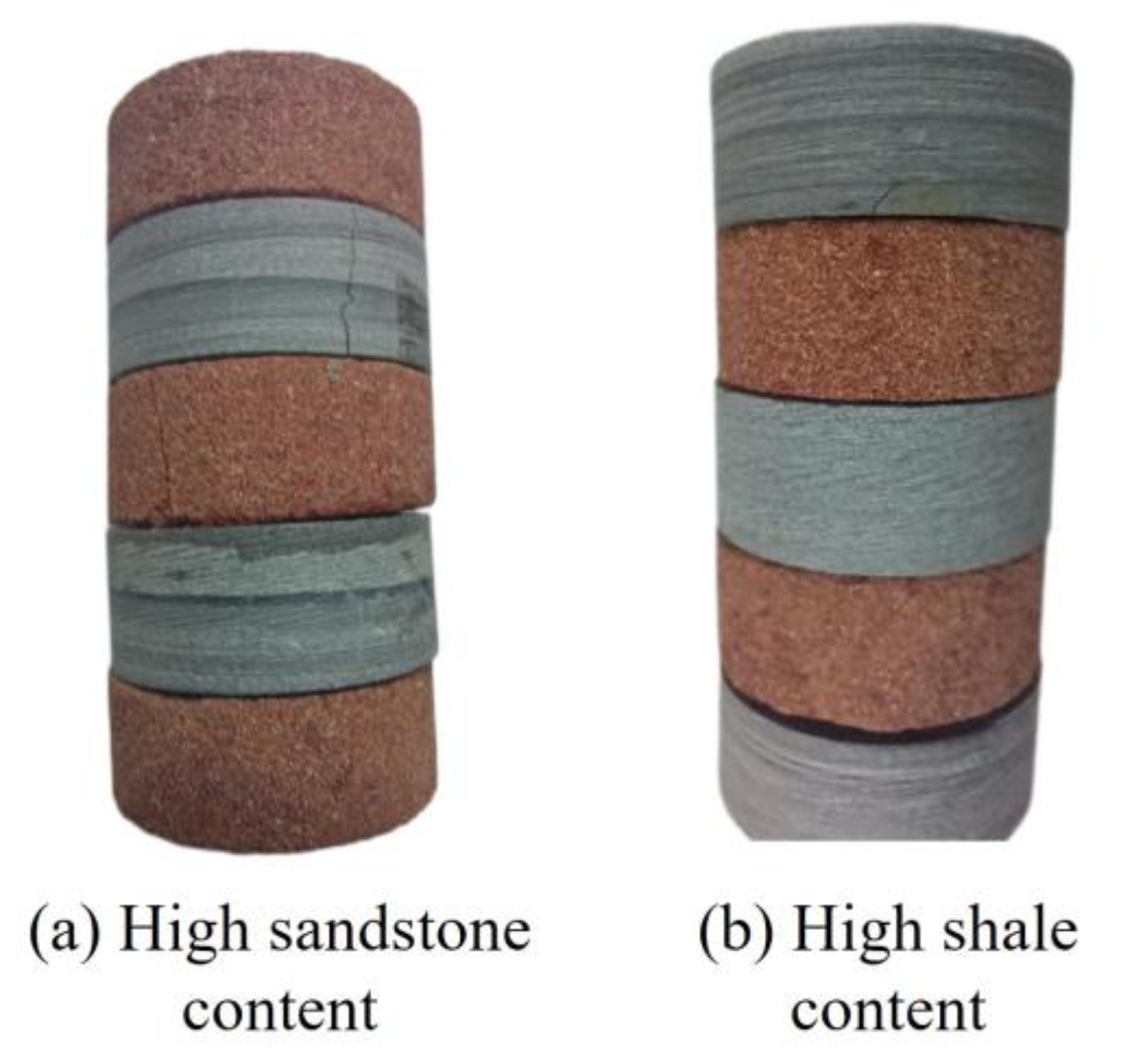
| Category | Type | Characteristic |
|---|---|---|
| 1 | Single rock mass | Shale and sandstone are sedimentary rocks, whose mechanical characteristics are closely related to structural composition. |
| 2 | Superimposed rock mass | It is composed of two kinds of rock mass with different strength. The thickness of each rock mass is relatively thick, and its mechanical properties are determined by two kinds of components. |
| 3 | Sandwiched rock mass | The sandwiched rock mass has a layered or banded soft (hard) thin layer, and its mechanical properties such as mechanical strength and elastic modulus are smaller (larger) than those of surrounding rock. |
| 4 | Interbedded rock mass | The interbedded rock mass is a kind of sedimentary type in which soft rock and hard rock alternate with each other in longitudinal direction and the thickness is small. The lithology shows frequent vertical alternations between soft and hard. |
| Grouping | Lithology | Proportion (H:S) | Number of Layers | Hierarchical Feature | Compressive Strength/MPa | Modulus of Elasticity/GPa |
|---|---|---|---|---|---|---|
| 1-1 | Shale | 1 | 200.67 | 34.72 | ||
| 1-2 | Sandstone | 1 | 37.37 | 9.66 | ||
| 2 | Shale-SandstoneAssociation | 1:1 | 2 | HS | 40.8 | 9.39 |
| 3-1 | 4:1 | 3 | HSH | 76.88 | 15.65 | |
| 3-2 | 3:2 | 3 | HSH | 41.77 | 12.63 | |
| 3-3 | 2:3 | 3 | HSH | 29.04 | 9.14 | |
| 4-1 | 1:4 | 3 | SHS | 29.64 | 6.02 | |
| 4-2 | 2:3 | 3 | SHS | 48.34 | 10.19 | |
| 4-3 | 3:2 | 3 | SHS | 67.05 | 10.93 | |
| 5-1 | 3:2 | 5 | HSHSH | 44.22 | 8.89 | |
| 5-2 | 2:3 | 5 | SHSHS | 48.17 | 8.28 |
Disclaimer/Publisher’s Note: The statements, opinions and data contained in all publications are solely those of the individual author(s) and contributor(s) and not of MDPI and/or the editor(s). MDPI and/or the editor(s) disclaim responsibility for any injury to people or property resulting from any ideas, methods, instructions or products referred to in the content. |
© 2023 by the authors. Licensee MDPI, Basel, Switzerland. This article is an open access article distributed under the terms and conditions of the Creative Commons Attribution (CC BY) license (https://creativecommons.org/licenses/by/4.0/).
Share and Cite
Zheng, Y.; Zhang, T.; Yang, H.; Wang, W.; Niu, Q.; Wei, H. An Experimental Investigation on Mechanical Properties and Failure Characteristics of Layered Rock Mass. Appl. Sci. 2023, 13, 7537. https://doi.org/10.3390/app13137537
Zheng Y, Zhang T, Yang H, Wang W, Niu Q, Wei H. An Experimental Investigation on Mechanical Properties and Failure Characteristics of Layered Rock Mass. Applied Sciences. 2023; 13(13):7537. https://doi.org/10.3390/app13137537
Chicago/Turabian StyleZheng, Yongxiang, Tongjing Zhang, Haotian Yang, Wei Wang, Qinghe Niu, and Haiyang Wei. 2023. "An Experimental Investigation on Mechanical Properties and Failure Characteristics of Layered Rock Mass" Applied Sciences 13, no. 13: 7537. https://doi.org/10.3390/app13137537
APA StyleZheng, Y., Zhang, T., Yang, H., Wang, W., Niu, Q., & Wei, H. (2023). An Experimental Investigation on Mechanical Properties and Failure Characteristics of Layered Rock Mass. Applied Sciences, 13(13), 7537. https://doi.org/10.3390/app13137537






